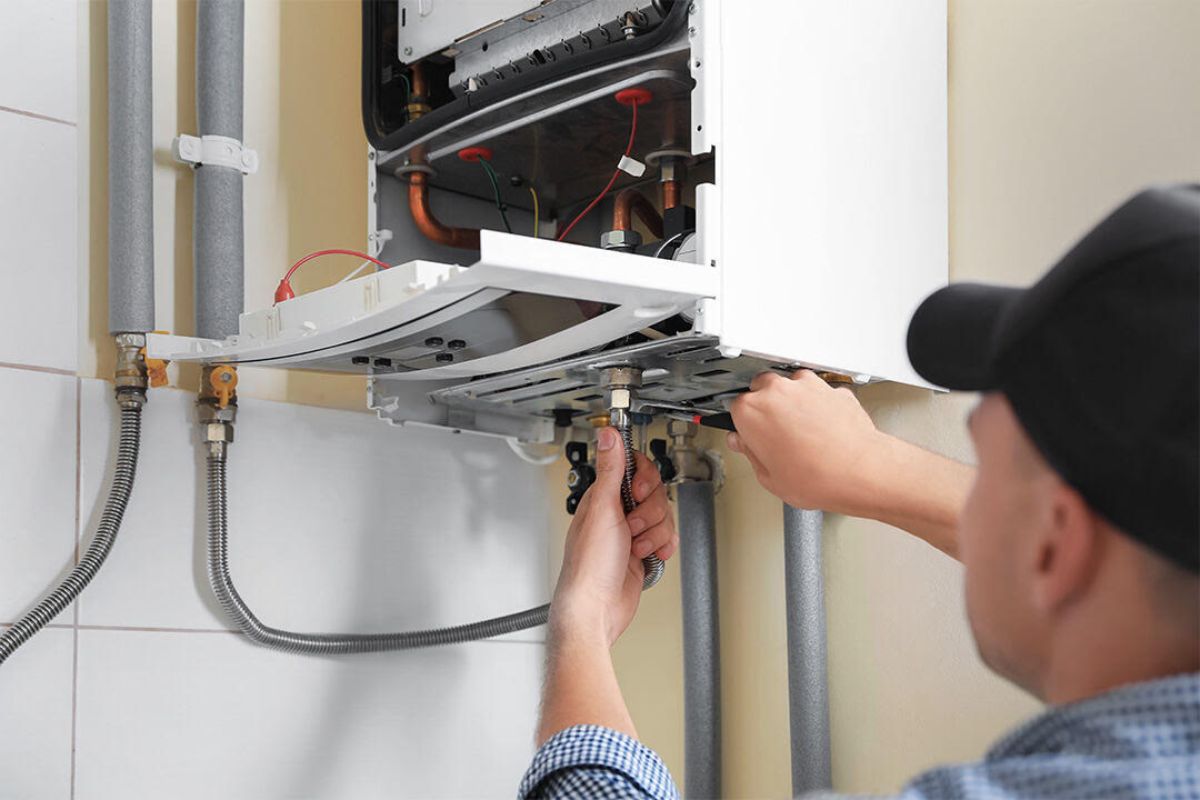The Process of Replacing a Back Boiler with a Modern Heating System

Many homes in the UK still use back boilers. These old heating systems are behind a fireplace. They heat water for your home but are not as efficient compared to modern condensing boilers. If you have such a tired heating system that is working for over its average life, this might be the right time for the back boiler replacement. A modern heating system can be safer and more efficient. This blog will explain step-by-step instructions on how to replace a back boiler.
Table of Contents
ToggleKnow Your Current Heating System
Before starting the replacement, know how your current heating system works. Back boilers heat water by burning gas or oil. This water then goes through pipes to radiators in your home. Some back boilers may also heat water for taps and showers.
However, they can be slow and waste energy. In the past, most of the installed heating systems, for instance, a back boiler or gas fire, are referred to as traditional systems. These also take time to heat up water hence water is heated in a storage tank beforehand. Considering modern options like underfloor heating can provide more efficient and quicker heating solutions. Learning about your existing system will enable you to decide on the better alternative options available for the system replacement.
Deciding on a New Heating System
Now that you have understood your back boiler, it is up to you to select a heater. There are a number of new boilers available. Combi boilers are known for their effectiveness in space saving. This is done by heating water straight from the main supply and not using a hot water tank.
System boilers, however, operate with the hot water tank. These are ideal for bigger houses which have high requirements for hot water. Evaluate your home’s dimensions and need for heat as you make this decision.
Finding a Qualified Installer
Generally, replacing a back boiler is not a good fit. It is essential that a professional installer be utilized. Seek a person who is Gas Safe registered. This implies that the person has the training and abilities to work with gas appliances without any risk. You could ask your friends or relatives if they know of any professionals.
You could also look for some reviews online. Obtain at least three estimates to settle down on the most affordable specialist. An installer who is experienced will assist in the selection of an ideal heating system for the homestead. He will then take care of the installation.
Preparing Your Home for Installation
Before the installer comes, you need to prepare your home. Clear the area around your back boiler and fireplace. Remove any furniture or decorations that might be in the way. This will give the installer enough space to work safely. Also, ensure that the heating system is turned off. This will make the process easier and safer. You may need to turn off your gas supply if the installer advises it.
The Installation Process
The installation of a new heating system usually takes one to three days. The first step is to remove the old back boiler. The installer will disconnect it from the gas supply and the water pipes. They will also take out the flue, which is the pipe that lets out gases.
After removing the old boiler, the installer will check the existing pipes. They will ensure everything is in good condition. Next, they will install the new boiler and connect it to the existing system.
Step 1: Preparation
- Clear the Area: Remove any furniture and decorations around the back boiler and fireplace to create a safe working space.
- Turn Off Heating: Ensure the heating system is turned off for safety. This may include shutting off the gas supply.
Step 2: Remove the Old Back Boiler
- Disconnect: The installer will disconnect the old back boiler from the gas supply and water pipes.
- Remove the Flue: They will also take out the flue pipe, which vents gases from the boiler to the outside.
Step 3: Check Existing Infrastructure
- Inspect Pipes: The installer will examine the existing water and gas pipes for any damage or issues.
- Make Necessary Repairs: If any problems are found, they will repair or replace the pipes to ensure a safe installation.
Step 4: Install the New Boiler
- Position the New Boiler: The installer will place the new heating system in the designated area.
- Connect Water and Gas Lines: They will connect the new boiler to the existing water and gas lines.
Step 5: Install the Flue
- Attach the Flue: The installer will fit the new flue to the boiler. This pipe directs exhaust gases outside.
- Ensure Proper Ventilation: Proper ventilation is crucial for safety and efficiency.
Step 6: Set Up the Controls
- Install Thermostat and Controls: The installer will set up the thermostat and any control systems for the new boiler.
- Explain Controls: They will show you how to adjust the temperature and set timers.
Step 7: Testing the New System
- Conduct Safety Checks: The installer will check for any gas leaks and ensure all connections are secure.
- Test Operation: They will run the new heating system to make sure everything is functioning properly.
Step 8: Final Adjustments
- Adjust Settings: Based on your preferences, the installer will adjust the settings for optimal performance.
- Walkthrough: They will provide a walkthrough of the system’s features and maintenance tips.
Step 9: Clean Up
- Remove Debris: The installer will clean up any debris or materials from the installation.
- Dispose of Old Boiler: They will properly dispose of the old back boiler and any other removed components.
Following these steps will ensure a smooth installation process for your new heating system. Remember to prioritize safety and efficiency while upgrading to a modern and reliable heating solution for your home.
Testing the New Heating System
Once the new boiler is installed, it will pass through the testing phase. Your installer will check for any leaks to avoid any disappointment. He will also explain how to use the new heating system.
Make sure to ask any questions you have about your new system. At that moment, the installer can show you how to adjust the thermostat and set timers at optimum levels. These seem to be ordinary points but will help you save energy in the long run.
Understanding the Costs
Replacing a back boiler can be costly. The price depends on the type of new heating system you choose. Combi boilers are usually less expensive than system boilers. Installation costs can also vary. It is important to budget for this project.
Some installers may offer payment plans or financing options. You can also check for government grants or schemes to help with the cost. This can make the transition to a modern heating system more affordable.
New Regulations & Smart Controls
As of 2025, the UK government has introduced tighter efficiency standards for all replacement boilers, meaning that any new installation must meet at least an A-rated ErP (Energy-related Products) efficiency label. In practice, this pushes installers and homeowners toward condensing models that recover more heat from flue gases.
You may also want to consider pairing your new boiler with a smart thermostat or zoning controls. Modern smart controls learn your daily routine and adapt boiler firing patterns accordingly—saving up to 20% on heating bills in a typical semi-detached house. Some models even connect via Wi-Fi, allowing you to monitor temperatures and usage from a smartphone app.
Before signing off on an installation estimate, ask your Gas Safe installer which compliant boiler models currently carry the highest seasonal efficiency (look for SEDBUK A or “ErP A” ratings), and which smart-control packages have been field-tested in homes similar to yours.
After Installation Care and Maintenance
Having an efficient unit installed in your home will guarantee you nothing without considering maintenance measures. Hire a qualified technician to conduct service checks every year after installation of the unit. In this way, the system will be able to operate at maximum efficiency and effectiveness.
During the visit, the technician will assess the state of the system and its fittings and guarantee that no safety risks are present. In addition, you are also encouraged to bleed the radiators once in a while in order to release air that is trapped inside them.
Such actions will boost the performance of the system. For one, such maintenance activities will promote the maintenance of the heating system, and the appliances will serve their purpose for a longer duration, reducing costs on energy bills.
Conclusion
Replacing a back boiler with a modern heating system is a great choice. It helps in making the entire home much more secure and energy-efficient. Begin by examining the system you already have and the logic of the replacement chosen. A professional replacement requires that you find a replacement technician with good experience.
Complete the preparations of your home for the process of installation and learn how to operate the new system. Finally, periodic servicing will ensure the effective operation of the heating apparatus. You will have good uninterrupted heating with the new system installed for many years!
Published by Seren Reynolds
Hi, i am a digital marketer with over 5 years of experience. I specialize in using online platforms and strategies to help businesses grow and engage their audiences. View more posts







